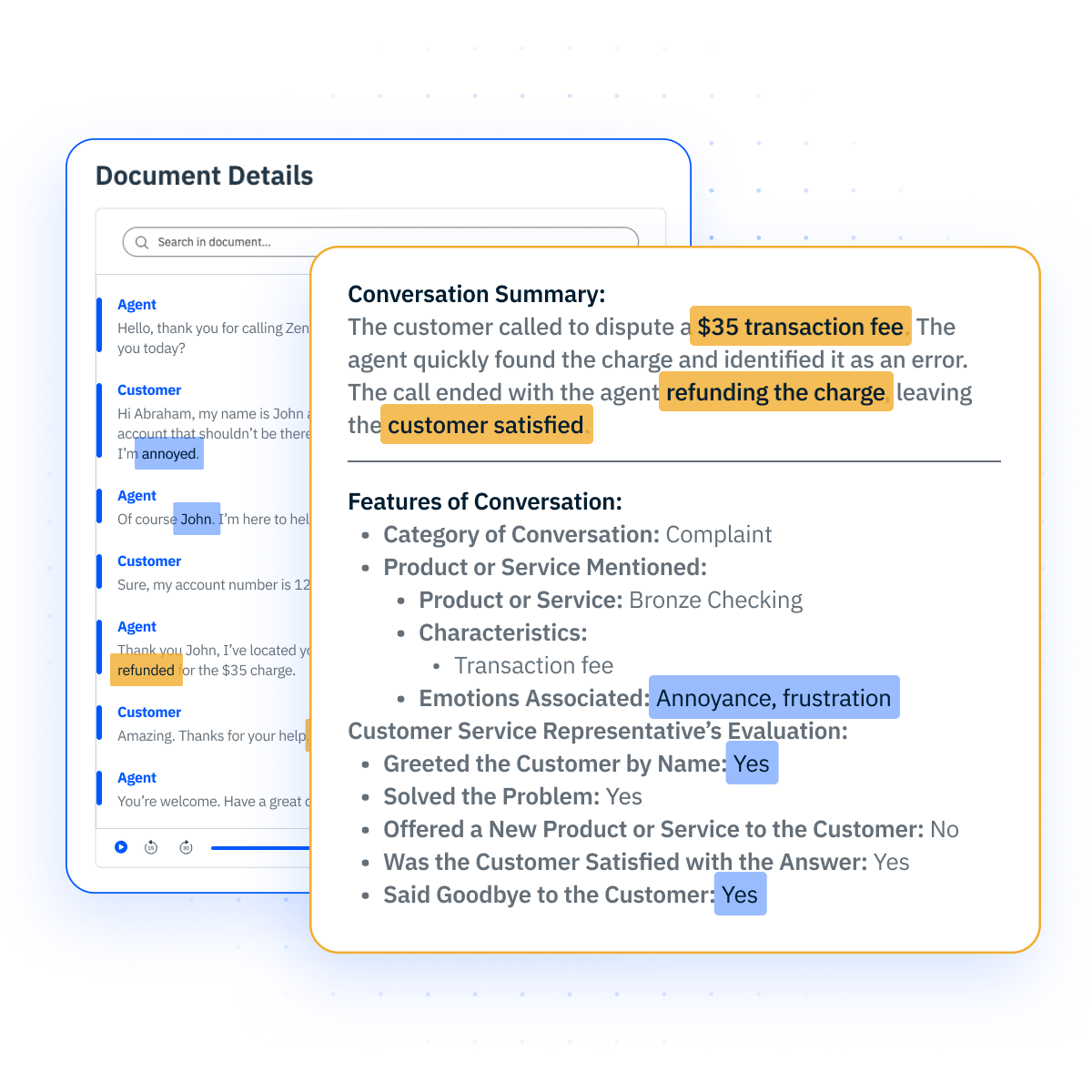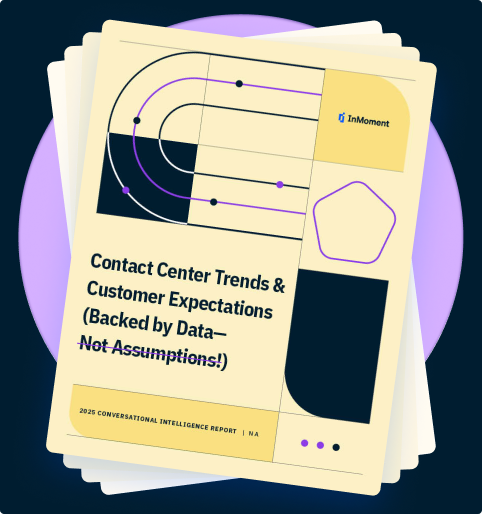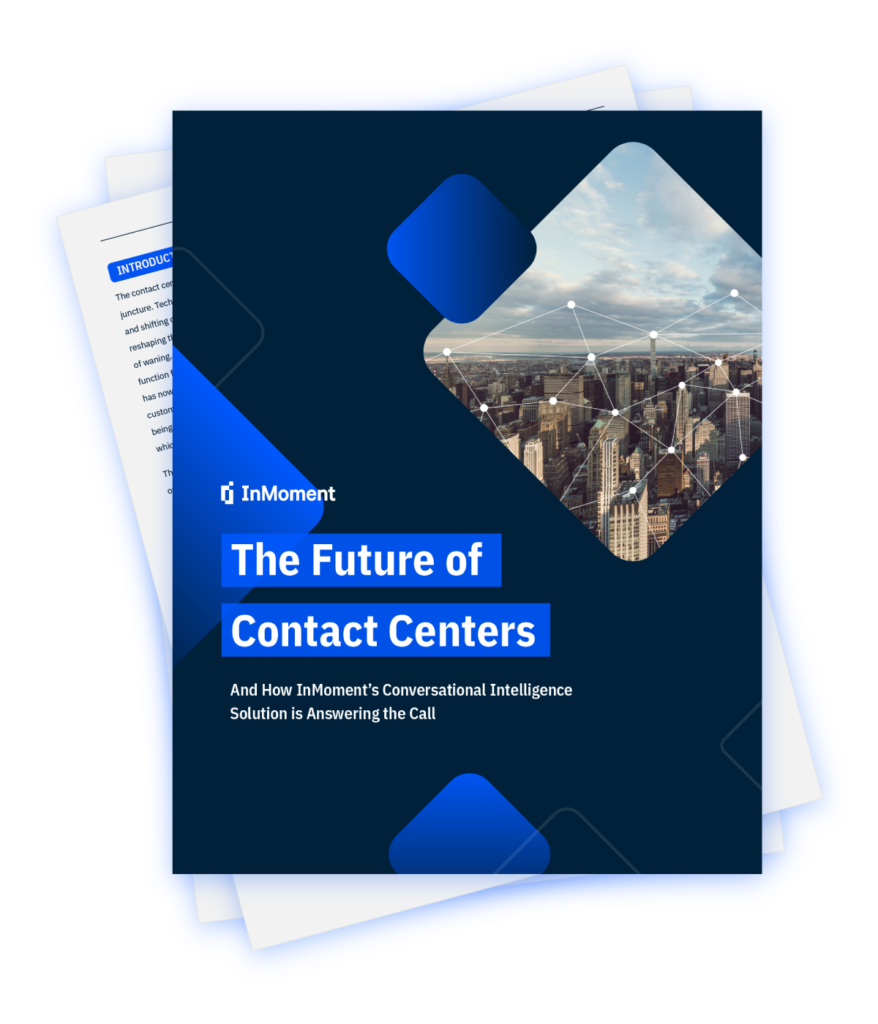
Meeting customer needs is one of the biggest challenges for the rapidly evolving banking industry. Financial services customers expect faster, smoother, and more personalized journeys. According to a 2023 Accenture survey of banking customers, 72% said that personalization influences their choice of bank.
These growing expectations call for AI-driven financial CX that delivers actionable insights for banks. Conversational intelligence offers such a solution that analyzes customer interactions at scale to enable smarter decision-making for banking CX teams.
The current CX challenges in banking
With 71% of consumers preferring two-way messaging with businesses, there is a growing expectation for smooth and frictionless experiences. However, many banks struggle to meet this expectation. Here are four common issues that erode trust and satisfaction for banking customers.
Long wait times and poor call routing
When customers need help, delays in reaching the right agent can quickly sour the experience. Long hold times, multiple transfers, or being routed to the wrong department signal inefficiency and a lack of empathy.
As a result, customers find it difficult to trust the bank’s ability to meet their needs. 61% of consumers are willing to leave a brand after just one negative experience, further increasing the impact of each CX misstep.
Generic or repetitive interactions
The last thing customers want to hear or see is a template response to their issues. They expect quick and empathetic communication that makes them feel heard. Without personalization or context, interactions feel disengaging, resulting in decreased customer loyalty.
Fragmented communication across channels
With multiple communication channels and siloed experience data, banks often struggle to build comprehensive views of customer experiences. Customers have to repeat themselves on different channels, since agents typically lack the full context. This disjointed experience leads to friction, longer resolution times, and a perception that the bank isn’t truly listening.
Inability to proactively identify and resolve pain points
The modern financial services customer expects proactive support every step of the way. For example, if there are banking products that can address their unique needs, they expect to be aware of them right away. This level of personalized service requires the use of analytical tools to spot emerging friction points and resolve them before it’s too late.
5 ways conversational Intelligence enhances CX in banking
Conversational Intelligence (CI) provides an AI-powered approach to enhancing customer experiences across financial institution touchpoints. It processes textual and audio data from multiple channels to provide comprehensive insights into customer behavior. Here are five powerful ways that effective data collection and analysis help improve CX in banking.
1. Reduces wait times and resolves issues faster
CI tools help triage inquiries in real time by identifying customer intent and urgency. Their ability to connect experience data from various channels saves time for businesses during customer interactions. For example, Pearl-Plaza provides CI capabilities as part of its omnichannel customer experience platform to enable better customer understanding and first-contact resolution.
2. Delivers personalized and contextual interactions
CI analyzes historical data and conversation patterns to help the human agents tailor their responses to each customer’s unique needs and situation. The result is a more empathetic and personalized interaction, whether for checking account balances or resolving complex disputes.
For example, if a customer calls her bank to ask about mortgage refinance, CI helps the support agent access the necessary context to help her. Perhaps she’s reached out via chat in the past or has expressed certain feelings in her reviews.
These prior questions, preferences, and sentiments make up the context that lets the agent pick up the conversation seamlessly. Instead of starting from scratch, agents leverage the AI-driven capabilities of CI to get straight to the point. As a result, customers feel heard and valued, improving their overall user experience.
3. Enables proactive support
CI tools detect early signals of dissatisfaction by leveraging sentiment analysis for customer feedback. This Natural Language Processing (NLP) technique uncovers intent, effort, and emotions in text to help financial institutions identify recurring issues. As a result, banks step in before problems escalate, improving retention and demonstrating attentiveness.
4. Increases agent effectiveness
CI boosts agent productivity by equipping them with all the information and context to make effective decisions. With real-time guidance, CI tools can suggest ideal responses, surface relevant knowledge articles, and provide compliance prompts as conversations unfold.
The availability of this information reduces the burden on customer support agents, allowing them to focus on improving customer engagement. Without worrying about fetching data or second-guessing protocols, agents lead smoother conversations and provide consistent service.
5. Provides insights to continually improve CX
Each customer interaction holds valuable insight for banks. Therefore, collecting reviews and saving chat transcripts isn’t enough; it’s far more helpful to understand what they represent.
CI supports this goal by continuously analyzing volumes of banking experience data to reveal sentiment trends, pain points, and emerging opportunities. These findings guide everything from product strategy to agent coaching programs, helping banks confidently evolve their CX strategy.
The use cases for conversational intelligence in banking
From contact centers to compliance teams, CI enables financial institutions to work smarter, respond faster, and create more cohesive customer journeys. Below are key use cases where conversational banking delivers value to agents, managers, and customers.
Contact center optimization
CI helps optimize contact center operations by automating repetitive tasks, identifying bottlenecks, and surfacing actionable insights for improvement.
For example, if there is a surge in customer queries about credit card reward programs, CI detects this trend in real-time and alerts CX teams. It also analyzes customer-agent interactions to reveal areas for improvement in response time and quality. Beyond this analysis, CI tools leverage automation to access customer data, suggest troubleshooting scripts, and route calls to the right agents.
As a result, agents don’t have to second-guess their next steps or spend valuable time on routine tasks. Instead, they can focus on delivering effective customer service that improves call center metrics like average handle time and repeat call rate.
Compliance and risk monitoring
Regulatory non-compliance has serious consequences for banks, including substantial penalties and reputational damage. CI helps generate evidence for proving compliance by capturing and maintaining accurate logs of all customer interactions. It also automatically detects regulatory red flags like failure to add a required disclaimer when talking to a customer. This proactive monitoring prevents the need for intensive manual review, making it easier for banks to ensure compliance and audit readiness.
Voice of the Customer (VoC) analysis
Understanding customer sentiment is crucial for building long-term trust and loyalty. With 80% of service organizations expected to use some form of AI by 2026, traditional surveys are no longer viable for feedback collection and analysis.
The way forward is conversational analytics, which captures emotion, intent, and recurring themes across volumes of online interactions. Pearl-Plaza’s core NLP engine, for instance, offers low-latency text extraction and analytics that process over five social media posts per second to provide real-time updates on customer sentiment.
Banks that use CI for VoC analysis gain a richer understanding of the customer journey and respond faster to changes in sentiment. This analysis boosts satisfaction and helps align decisions with what truly matters to customers.
Training agents and managing performance
A key application of conversational analytics is managing customer support agent performance. The tool digs into customer-agent interactions to highlight wins as well as areas for improvement.
The data-driven insights provide excellent agent coaching opportunities. For example, agents exhibiting low empathy during high-stress interactions likely don’t work well under pressure. As a result, managers can tailor a unique training program for them without relying on a one-size-fits-all approach.
Automating how calls are categorized
Manual tagging for call categorization is time-consuming, error-prone, and inconsistent across agents. CI streamlines the tagging process by automatically detecting the topic, intent, and emotional tone of each conversation. It applies machine learning models trained on historical interaction data to assign categories in real-time.
Automating this process improves data quality, saves valuable agent time, and enables banks to generate more reliable reports. It also enhances trend analysis, making it easier to identify high-priority categories for CX improvements.
Identifying and resolving the root cause behind issues
Conversational analytics supports proactive customer service by unifying insights across channels. From virtual assistants and AI chatbots to mobile banking apps and phone calls, each channel features customer experience signals that CI connects to uncover systemic patterns.
For example, if there is a pattern of frustration regarding delayed transactions, CI surfaces this insight so the bank can investigate. This process uncovers underlying issues for the bank to address before it’s too late. As a result, financial institutions proactively meet customer expectations while driving product improvements.
Quality assurance
CI transforms quality assurance (QA) by automatically evaluating each customer-agent interaction. The tool scores conversations against pre-defined metrics like tone, compliance, and empathy to provide an objective view of performance trends. This automation ensures consistent service quality across teams by eliminating human oversight or bias.
Conversation continuity across channels
According to the 2023 Zendesk CX Trends Report, 70% of banking customers expect everyone they interact with at the bank to have full context. This expectation highlights the importance of establishing conversation continuity across multiple channels. If a customer voices a complaint via support chat, they expect the agent to know their issue when they pick up the phone, too.
CI ensures this continuity by working within an omnichannel system like the Pearl-Plaza XI Platform. It connects and collects interactions across channels to provide a comprehensive view of each customer journey. As a result, agents can pick up right where the last conversation left off, saving time and reducing friction.
Getting started with conversational intelligence in banking
Conversational AI is the next step forward for banks looking to stay competitive and improve service quality. Here’s a step-by-step guide for moving from strategy to impact:
1. Define your objectives
Start by outlining your specific CX goals. Are you aiming to improve response times, enhance compliance, reduce call volume, or streamline agent coaching? Clear goals will guide your platform selection and rollout strategy.
2. Select the right CI platform
The right CI platform will save you valuable time and effort without straining your existing resources. Pearl-Plaza’s conversational analytics platform checks that box by seamlessly integrating with your existing system to offer a range of capabilities, from omnichannel analysis to automated conversation tagging. These features support your CX efforts by taking care of the analytical heavy lifting, allowing you to focus on the human touch.
3. Integrate it into your banking workflow
The right tool will also offer robust CX integrations to smoothly connect with your CRM or automation platforms. This feature enables unified data capture and allows insights to flow freely across teams and touchpoints.
4. Focus on key metrics
With the volume of data at your disposal, it’s crucial to determine the metrics that matter most to your team. Without this focus, you will feel overwhelmed, and your agents will lack a clear definition of success.
Start by considering the goals you set at the beginning. If your priority is reducing operational cost, metrics like cost per call, average handle time, and first call resolution are key focus areas. Once you’ve determined the right metrics for your goals, you can better adjust your CX strategies.
5. Train your customer support team
Your CI tool of choice will deliver real value when your team uses it the right way. Beyond explaining the tool’s features, train them on surfacing insights from it and using the information to deliver CX improvements. For example, show them how sentiment analysis of call transcripts reveals intent and emotional state. Guide them on transforming this insight into action that boosts customer satisfaction in future calls.
6. Refine and scale
Continue to improve and scale your platform by tracking progress against your initial objectives. Once you start seeing the desired outcomes, you will feel more confident about expanding your use case or evolving your CX strategy.
Stay up-to-date on changing customer expectations with the help of artificial intelligence and automation. From trend analysis to keyword alerts, leverage CI features to continuously improve and amplify the impact of your CX efforts.
Elevate your bank’s CX strategy with Pearl-Plaza
Conversational intelligence offers an incredible competitive advantage to banks in the modern age. From using generative AI for empathetic responses to surfacing insights from volumes of customer interaction data, the tool is a game-changer for customer-centric financial institutions.
Pearl-Plaza’s conversational analytics platform brings together all the features necessary to exceed customer expectations. It captures, connects, and analyzes experience data from every relevant channel to highlight actionable insights. The result is a data-driven approach to customer service that improves agent performance and key CX metrics.
Schedule a demo today to see how Pearl-Plaza’s conversational intelligence software can help enhance your bank’s reputation and customer loyalty!










